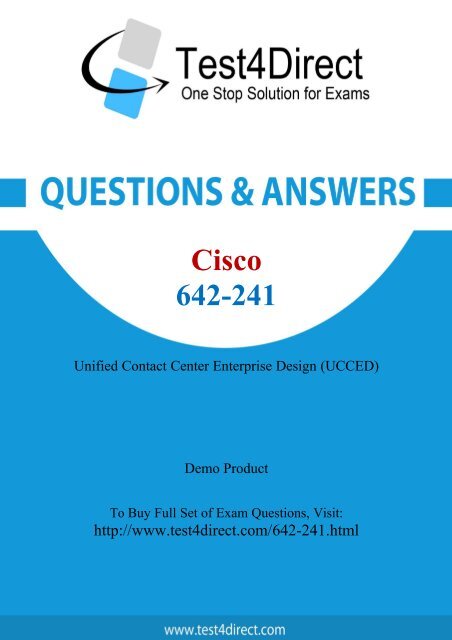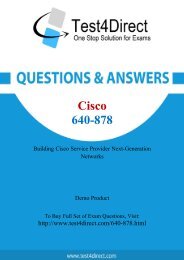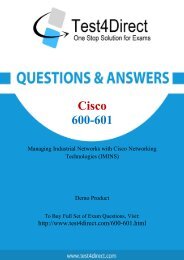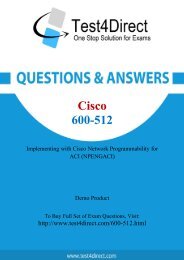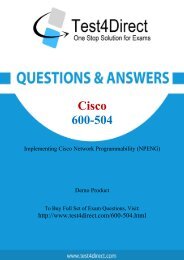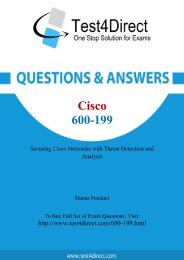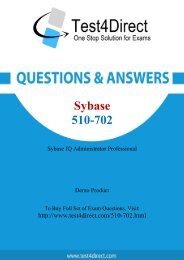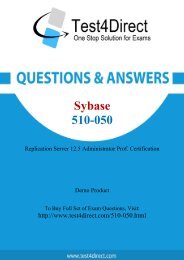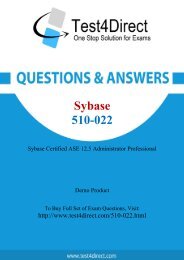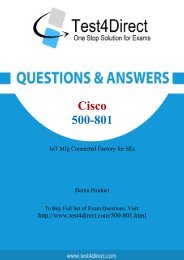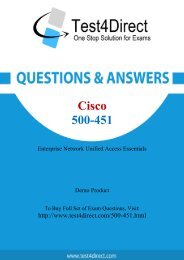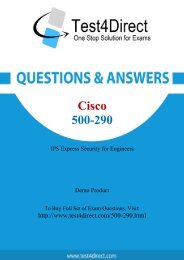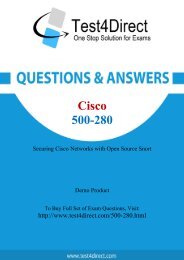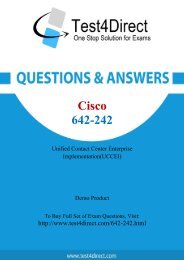642-241-demo
You also want an ePaper? Increase the reach of your titles
YUMPU automatically turns print PDFs into web optimized ePapers that Google loves.
Cisco<br />
<strong>642</strong>-<strong>241</strong><br />
Unified Contact Center Enterprise Design (UCCED)<br />
Demo Product<br />
To Buy Full Set of Exam Questions, Visit:<br />
http://www.test4direct.com/<strong>642</strong>-<strong>241</strong>.html
Question: 1<br />
Which protocol does the Cisco Unified ICM use to interface with the Cisco Unified Communications<br />
Manager in the Cisco Unified Contact Center Enterprise solution?<br />
A. AXL<br />
B. SIP<br />
C. H.323<br />
D. JTAPI<br />
E. SOAP<br />
Question: 2<br />
How does Cisco Unified Contact Center Enterprise provide security to the system?<br />
Question: 3<br />
Question: 4<br />
Answer: D<br />
A. Microsoft Windows Active Directory is used to control access to the system.<br />
B. Microsoft SQL Server accounts and logins for all users are used to control access to the system.<br />
C. Cisco Synchronization Service is used to control access to the system.<br />
D. Administrator accounts for the system are encrypted and kept in the Cisco Unified Contact Center<br />
Enterprise database to control access to the system.<br />
Answer: A<br />
What is the impact of using a Call Type node in a routing script for the Cisco Unified Contact Center<br />
Enterprise system?<br />
A. The call type is changed and maintains the old data in the original call type.<br />
B. The call is reset to the new call type, like a new call with all counters reset to zero.<br />
C. There is no impact, the call type is only used for the initial script selection process.<br />
D. The call is reclassified and the system picks a new routing script based on the call type.<br />
Answer: A<br />
The process of sending pre-call data about a call to a targeted site in the Cisco Unified Contact Center<br />
Enterprise solution is known as which of these terms?<br />
A. pre-routing<br />
B. post-routing<br />
C. translation routing<br />
D. event-based routing
E. service control routing<br />
Answer: C<br />
Question: 5<br />
What is the recommended way to configure redundant Cisco Unified Communications Manager<br />
subscribers for Cisco IP phone registration in a single cluster for the Cisco Unified Contact Center<br />
Enterprise solution?<br />
A. add a redundant device pool to the Cisco Unified CallManager Group configuration<br />
B. add a second TFTP server to the cluster<br />
C. add an additional Cisco Unified Communications Manager subscriber to the Cisco Unified<br />
Communications Manager Group defined in Device pool of the Cisco IP Phone<br />
D. use an SRST reference in the device pool<br />
Question: 6<br />
Question: 7<br />
Question: 8<br />
Answer: C<br />
Under which circumstances can the visible and private networks be converged in the Cisco Unified<br />
Contact Center Enterprise system?<br />
A. when QoS is enabled on both networks<br />
B. in cases in which there is gigabit bandwidth between sites<br />
C. under no circumstances<br />
D. when the Cisco Catalyst switch has dual power supplies<br />
Answer: C<br />
In a Cisco Unified Contact Center Enterprise deployment with geographically redundant central<br />
controllers, a new site is added with two new Admin Workstations as the only AWs at the site. What<br />
is the recommended configuration (AW type) for these two machines?<br />
A. 1 - Primary Distributor AW, 1 - Secondary Distributor AW<br />
B. 1 - Primary Distributor AW, 1 - Client AW<br />
C. 1 - Secondary Distributor AW, 1 - Client AW<br />
D. 2 - Client AWs<br />
E. 2 - Secondary Distributor AWs<br />
F. 1 - Primary Client AW, 1 - Secondary Client AW<br />
Answer: A<br />
What role does Cisco Unified Communications Manager play in the Cisco Unified Contact Center<br />
Enterprise solution?
A. automatic call distribution<br />
B. integrated call distribution<br />
C. interactive voice response system<br />
D. call switching to agent and Cisco Unified IP IVR<br />
Answer: D<br />
Question: 9<br />
When sizing the Cisco Unified Communications Manager cluster in a Cisco Unified Contact Center<br />
Enterprise solution with the Cisco Unified IP IVR, which factor must be taken into account?<br />
A. the number of dialed numbers configured in the Cisco Unified Contact Center Enterprise Call<br />
Router<br />
B. the maximum number of concurrent calls in progress in the Cisco Unified IP IVR, serviced by CTI<br />
ports<br />
C. the number of Run VRU script nodes executed by the Cisco Unified Contact Center Enterprise<br />
routing script once the call is terminated in the Cisco Unified IP IVR<br />
D. the total number of CTI route points, CTI ports, and BHCAs associated with the Cisco Unified IP IVR<br />
E. the maximum number of concurrent agents in the Cisco Unified Contact Center Enterprise system<br />
Question: 10<br />
Question: 11<br />
Answer: D<br />
Which function is not provided by the Cisco Gatekeeper software in a Cisco Unified Contact Center<br />
Enterprise deployment?<br />
A. to register H.323 endpoints and associate them with specific dialed numbers<br />
B. to provide CAC in a Cisco Unified Contact Center Enterprise multisite distributed call-processing<br />
deployment<br />
C. to control bandwidth utilization in a Cisco Unified Contact Center Enterprise multisite centralized<br />
call-processing deployment<br />
D. to provide a GKTMP interface to a Cisco Unified ICM solution<br />
Answer: C<br />
In Cisco Unified Contact Center Enterprise 7.0.x and 7.1.x, which domain-level group is used to<br />
control access to Script Editor?<br />
A. Setup group<br />
B. Services group<br />
C. Configuration group<br />
D. Internet Script Editor group<br />
Answer: C
Question: 12<br />
When Cisco Unified Contact Center Enterprise is deployed with Cisco Unified IP IVR as the queue<br />
point, where does Ring No Answer treatment get defined?<br />
A. In the Cisco Unified IP IVR application editor script<br />
B. In the Cisco Unified Contact Center Enterprise Agent desk settings in ConfigManager<br />
C. In the re-query node in the Cisco Unified Contact Center Enterprise routing script<br />
D. In the Cisco Unified Communications Manager Call Forward No Answer setting<br />
Answer: B
THANKS FOR TRYING THE DEMO OF OUR PRODUCT<br />
Visit Our Site to Purchase the Full Set of Actual <strong>642</strong>-<strong>241</strong> Exam Questions With Answers.<br />
http://www.test4direct.com/<strong>642</strong>-<strong>241</strong>.html<br />
We Also Provide Practice Exam Software That Simulates Real Exam Environment And Has<br />
Many Self-Assessment Features. Download Free Product Demo From:<br />
http://www.test4direct.com/<strong>642</strong>-<strong>241</strong>.html<br />
Money Back Guarantee<br />
Check Out Our Customer Testimonials


